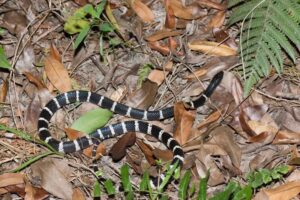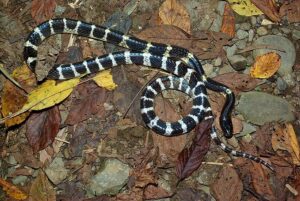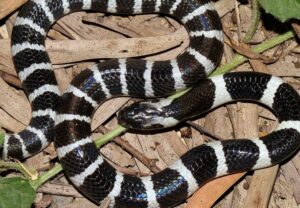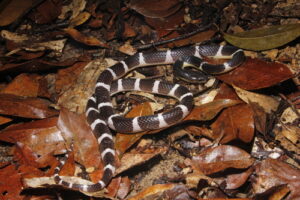The many-banded krait, also called the Taiwanese krait or the Chinese krait, is an extremely venomous species in the elapid family.
This species was first described in 1861 by zoologist and pharmacist Edward Blyth. He noted that it had much more bands than the banded krait. Their genus name, ‘Bungarus‘, derives from the Latinized Telugu word ‘baṅgāru‘ meaning “krait”. And the species epithet ‘multicinctus‘ is derived from Latin by combining multiple words, such as multus, meaning “much, many”, and cinctus, which is the past participle of cingere, meaning “to encircle”.
Scientific Classifications
- Suborder:Serpentes
- Family:Elapidae
- Genus:Bungarus
- Species:B. multicinctus
Conservation Status
Subspecies
The many-banded krait has two known subspecies,
- Bungarus multicinctus multicinctus
- Bungarus multicinctus wanghaotingi
Description
Size
These are medium-large snakes growing up to 3.5 to 5 ft (1-1.5 m) with a maximum size reaching 6 ft (1.8 m).
Color and Appearance
They have slender bodies with dark bluish-black color, broad oval-shaped but slightly flat heads that are primarily black and distinct from the bodies, and a relatively short pointed tail. Their eyes are black and small with black pupils that blend with the eyes and are hard to notice; they also have large nostrils and small fixed fangs located at the frontal part of the upper jaws. These kraits have red to flesh-colored tongues with a red-colored stem whose branches gradually fade to grey. Creamy-white to white crossbands cover the entire length of their upper part bodies up to the tails, and their bellies are usually off-white or white. On an average size snake, these bands are approximately 21-30 with 7-11 at tails, but more bandings can be seen on longer specimens. Juveniles tend to have white spots on the ventral side of their heads.
Their scales are glossy and smooth, with a distinct vertebral ridge. They have 15 dorsal scale rows in the middle, and their anal scales are undivided. In males, 200-231 ventral scales are seen, with undivided subcaudal scales being 43-54. Females’ ventral scales are 198-227, and their subcaudal scales are 37-55.
Are they Dangerous
The venom of a many-banded krait has an LD50 value of 0.09-0.108 mg/kg and a yield of about 4.6 mg-19.4 mg per bite, and it contains both pre-synaptic and postsynaptic neurotoxins.
Victims might feel slightly itchy and numb when bitten, and there will be no excessive bleeding, severe swelling, or pain. Symptoms may occur between one to six hours after being bitten, which include ataxia, bilateral ptosis, difficulty breathing, diplopia, discomfort in the chest, dysphagia, general ache, loss of voice, tunnel vision, and weak limbs; hyponatremia also occurs, but rarely. The interval between bite and death is 12 to 30 hours.
In southern China, a considerable rate of mortality and morbidity is caused by these snake bites. The bite rate of many-banded krait is rare in Taiwan, accounting for only 7.5% of all snake bites in the country.
Joe Slowinski, a snake charmer, was bitten by a juvenile specimen in Myanmar on 11 September 2001, leading to his death on the following day, 29 hours after being bitten.
Many-Banded Krait At a Glance
Distribution
Commonly found in Southeast Asia and central and southern China, the distribution of this species ranges across the provinces of Anhui, Fujian, Guangdong, Guangxi, Guizhou, Hainan, Hubei, Hunan, Jiangxi, Sichuan, Yunnan, and Zhejiang in China, Taiwan, including the Archipelagos of Matsu and Kinmen, Hong Kong, Myanmar, Laos, and northern Vietnam. Some populations may also live in Thailand.
Habitat
Chinese kraits prefer to inhabit lowland areas, mostly subtropical and marshy regions across their range. They spend much of their time in agricultural fields, mangroves, shrublands, and woodlands, as well as in areas with rivers, streams, and ditches. These snakes often enter human settlements like villages and suburban areas. The many-banded krait can be found at an altitude of 4,900 ft (1,500 m).
They are solitary creatures showing nocturnal behavior. During the day, they usually hide in holes or under rocks. The only time of the year many-banded kraits appear is from April to late October. In November, they go into hibernation.
Lifespan
They survive up to nine years in the wild. In captivity, one individual was recorded to have lived 13.7 years.
Predators
Predators that hunt these snakes are unknown. However, it can be assumed that they share similar enemies with other elapids throughout their region.
These snakes are shy and even-tempered but highly defensive, especially at night. Despite being timid, they can strike from multiple directions and, if threatened, will readily do so without prior warning signs.
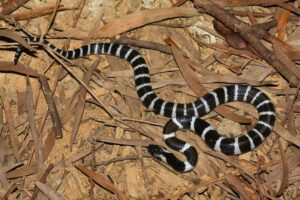
Diet
Unlike the similar species in its genus that primarily consume snakes, this species’ diet mainly consists of fish. But it also consumes snakes of other species as well as their own species. They also feed on eels, frogs, rodents, and sometimes lizards.
They hunt on the ground, attacking quickly upon locating prey.
Reproduction
Information regarding their reproduction is limited. The mating season occurs in August and lasts through September. Many–banded kraits are oviparous. Between late spring to early summer, they lay about 3-15 eggs per clutch, with a maximum of 20 eggs. After about 30-45 days of incubation, hatchlings emerge, each measuring 9.8 inches (25 cm).
Similar Species
Malayan Krait
The Malayan and many-banded kraits share many similarities and are hard to tell apart. However, the interspaces between bands in Malayan kraits have a white-to-yellowish tone that many-banded kraits lack.
Banded Wolf Snake
Both banded wolf snakes and many-banded kraits have similar black-and-white banding. But the banded wolf snake’s bandings are broader and lower in count than the many-banded krait’s.
Futsing Wolf Snake
The futsing wolf snake has a similar appearance to the many-banded krait. But it can be easily distinguished from the many-banded krait by its broader head and pink to grey banding instead of cream to white.
Source
animalia.bio, snakesoftaiwan.com, alchetron.com, inaturalist.org, i.pinimg.com

